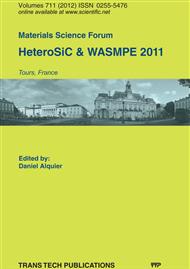p.70
p.75
p.80
p.84
p.91
p.99
p.104
p.109
p.114
High Quality 3C-SiC Substrate for MOSFET Fabrication
Abstract:
Quantitative efficacies of several methods for stacking fault (SF) reduction are evaluated using Monte Carlo (MC) simulation. SF density on a 3C–SiC {001} surface depends on interactions of adjoining SFs: annihilation between counter pairs of SFs and termination by orthogonal SF pairs. However, SFs are not entirely eliminated when growth occurs on undulant-Si and switch back epitaxy (SBE) due to spontaneous SF collimation that suppresses the annihilation probability of counter SFs. The MC simulation also reveals the efficacy of SF reduction method which includes the growth of 3C–SiC on finite area bounded by side walls. One can theoretically reduce the SF density below 100 cm-1 on 3C–SiC {001} surface. A practical way for eliminating the SF by termination at side walls is demonstrated, and it clearly exhibits that the SF density can be reduced under 120 cm-1.
Info:
Periodical:
Pages:
91-98
Citation:
Online since:
January 2012
Price:
Сopyright:
© 2012 Trans Tech Publications Ltd. All Rights Reserved
Share:
Citation:


